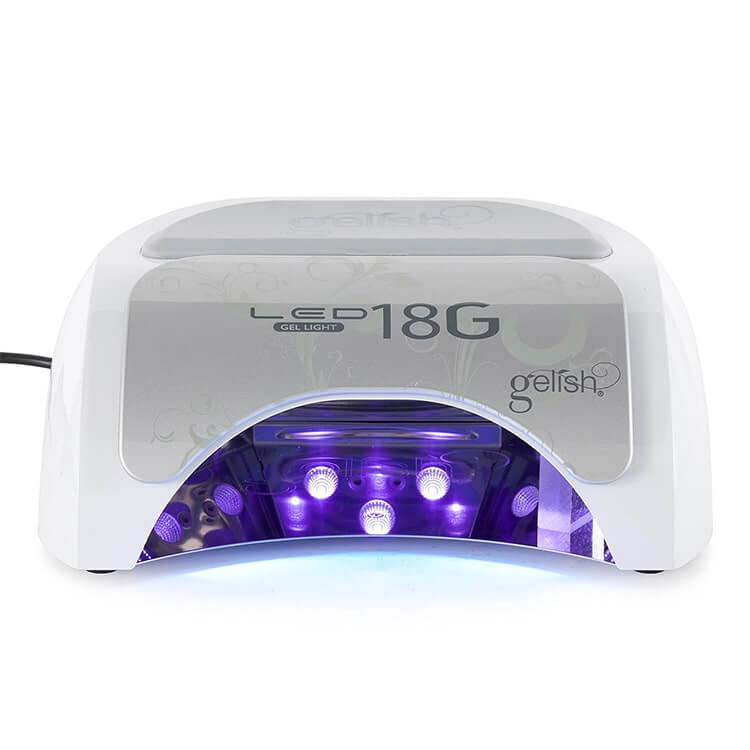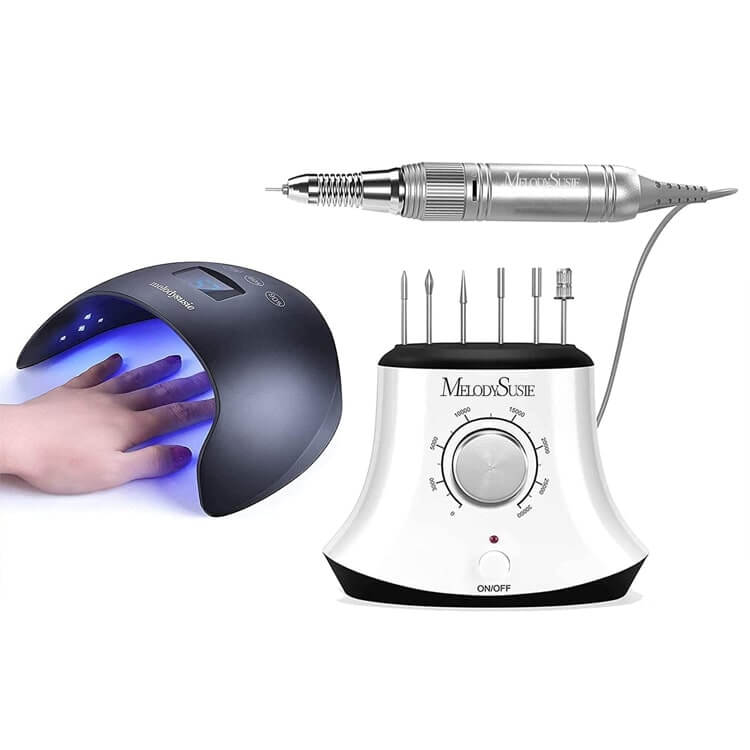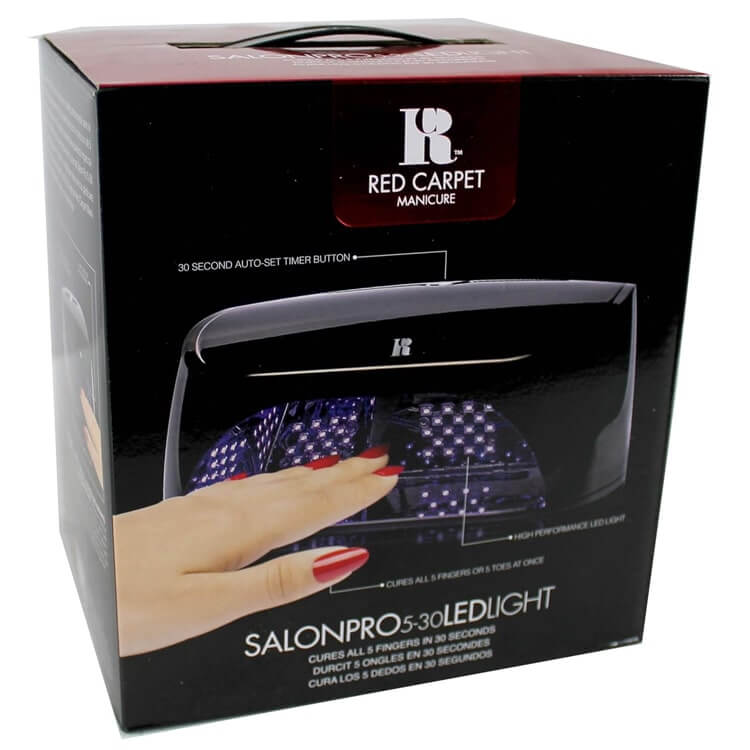Read in this article:
Understanding the LED Nail Lamp
What is an LED Nail Lamp?
An LED nail lamp is a specialized device used primarily for curing gel nail polish. “LED” stands for Light Emitting Diode, which is a semiconductor light source that emits light when a current passes through it.
This light, when targeted correctly, can set or “cure” certain types of nail polish, particularly gel-based polishes, providing a quick, durable, and shiny finish.
Functionally, an LED nail lamp serves the following purposes:
- Fast Curing: LED lamps can cure gel nail polish in a matter of seconds (often 30 seconds to a minute), considerably faster than traditional UV lamps.
- Durability: By using LED lamps to cure gel nail polish, one can achieve a finish that is resistant to chipping or peeling for up to two or three weeks.
- Versatility: Some LED nail lamps are designed to work with a broader range of gel polishes, and newer models often come with adjustable settings for varied curing needs.
Difference between LED and Traditional UV Lamps:
- Technology: At the core, LED and UV lamps employ different technologies. LED lamps use light-emitting diodes, while traditional UV lamps utilize ultraviolet light bulbs.
- Curing Time: LED nail lamps generally cure gel polishes faster than UV lamps. A typical LED lamp might take 30 seconds to 60 seconds to cure a layer of gel polish, whereas a UV lamp might take 2-3 minutes for the same task.
- Lifespan: LED lights have a significantly longer lifespan compared to UV bulbs. An LED lamp can last up to 50,000 hours, while UV bulbs may need replacement after 100 to 1,000 hours of use.
- Safety: LED lamps emit a narrower range of UV light, which some argue makes them safer than traditional UV lamps. However, both types of lamps emit UV radiation, so it’s essential to take precautions like applying sunscreen to the hands to prevent potential UV damage.
- Cost: Initially, LED nail lamps were more expensive than traditional UV lamps. However, due to their longer lifespan and reduced curing times, many professionals and DIY enthusiasts find them to be cost-effective in the long run.
While both LED and UV lamps serve the primary purpose of curing gel nail polish, they differ in technology, curing time, lifespan, safety, and cost. The choice between the two often boils down to personal preference, specific needs, and budget considerations.
The Science Behind LED Nail Lamps
LED, or Light Emitting Diode, is a semiconductor light source. When an electrical current passes through it, it emits light. Unlike traditional incandescent bulbs that produce light by heating a filament, LEDs produce light through electroluminescence, a process where light is emitted from a material when it’s energized.
Photoinitiators and Curing Process:
Presence in Gel Polish: Gel nail polishes are formulated with chemicals known as photoinitiators. These chemicals respond to specific light wavelengths.
Activation by LED Lamp: The light emitted from an LED nail lamp is of a particular wavelength that activates the photoinitiators present in the gel polish.
Polymerization: Upon activation, these photoinitiators start a chemical reaction termed polymerization. This reaction causes the molecules of the gel polish to bond together, creating a solid, durable structure on the nail. This transformation from a viscous gel polish to a hardened, glossy finish is what is referred to as “curing.”
Benefits of Using LED for Curing:
Swift Curing Time: LED lamps can cure gel polish rapidly, usually within 30 seconds to a minute per layer.
Energy Efficiency: LEDs consume less electricity compared to traditional UV bulbs, marking LED lamps as more energy-efficient.
Longevity: LEDs typically have a longer lifespan, often outlasting UV bulbs by many years.
Safety and Health Implications of LED Nail Lamps
UV Exposure: While LED nail lamps are faster and more energy-efficient than traditional UV lamps, they still emit UV radiation. This radiation is what activates the photoinitiators in gel polish, allowing it to cure. However, exposure to UV radiation can have potential risks.
Potential Risks Include:
- Skin Aging: Repeated and prolonged exposure to UV radiation can accelerate the aging process of the skin, leading to wrinkles, age spots, and loss of skin elasticity.
- Skin Cancer: There’s a concern, though minimal, about the potential risk of skin cancer from repeated exposure to UV light from nail lamps.
- Eye Safety: Direct exposure or even glare from the UV light can be harmful to the eyes. There’s a potential risk for cataract formation and other UV-induced eye conditions.
Safety Precautions:
- Limit Exposure: Limit the frequency of gel manicures to reduce UV exposure.
- Wear Protective Gear: Consider wearing UV-protective gloves with the fingertips cut off during the curing process.
- Use Sunscreen: Apply a broad-spectrum sunscreen to the hands before using an LED nail lamp.
- Avoid Direct Eye Exposure: Never look directly at the LED light. Some salons provide protective eyewear for added safety.
While LED nail lamps offer numerous advantages, including speed and efficiency, it’s essential to be aware of the potential health risks associated with UV exposure. By taking proper precautions, one can enjoy the benefits of gel manicures while minimizing potential hazards.
Choosing the Right LED Nail Lamp for You
Selecting the perfect LED nail lamp requires consideration of several critical factors, ensuring you get the most out of your manicure sessions. Here’s a breakdown of what you need to look out for:
1. Wattage and Its Importance:
- Definition: Wattage represents the power output of the lamp. It’s an indicator of how much energy the lamp uses and, often, how effective it is at curing gel polish.
- Why It’s Important: Higher wattage typically means faster curing times. A powerful lamp can cure nails in less time, ensuring a more efficient manicure process. However, it’s essential to strike a balance; excessively high wattage might result in overheating or over-curing, which could damage nails or reduce the longevity of the manicure.
- Recommendation: Look for LED nail lamps in the range of 24 to 48 watts for optimal curing. Remember, the specific wattage required may vary depending on the type and brand of gel polish you use.
2. Size and Design Considerations:
- Lamp Size: Consider how many fingers or toes the lamp can accommodate. Some lamps are designed for one finger at a time, while others can cure all five simultaneously, speeding up the process.
- Portability: If you travel frequently or need to move the lamp often, consider its weight and design. Compact, lightweight models are available for those on-the-go.
- Design Aesthetics: While functionality is crucial, you might also want a lamp that looks good on your table. Fortunately, many models come in sleek, modern designs that can complement any décor.
3. Timer Settings and Automatic Sensors:
- Timer: Most quality LED nail lamps come with built-in timers. These timers typically have settings for 10, 30, 60, and sometimes 90 seconds. They allow for precise curing times, ensuring you don’t under or over-cure the gel polish.
- Automatic Sensors: Advanced LED nail lamps feature motion sensors that automatically turn on the light when you place your hand inside and turn off when you remove it. This feature enhances the ease of use, ensuring energy efficiency and preventing unnecessary UV exposure.
4. Popular LED Nail Lamp Brands and Models:
Gelish 18G: A favorite among professionals, this model offers fast curing times and a comfortable sliding tray.
 | Gelish 18G Professional Gel Polish Curing LampPowerful, portable, and easy to use: the Gelish Mini Pro provides professional results anywhere your polish needs a touch-up. |
SUNUV Sun2: Known for its versatility, this lamp can cure both LED and UV gels and features an array of timer settings.
 | The Choice of 5 Million ProfessionalsThe brand is trusted by over 5 million professionals and salons worldwide for its superior quality and ease of use. |
MelodySusie Scarlet: A compact yet powerful device suitable for both home and salon use.
 | The Choice of 5 Million ProfessionalsThe brand is trusted by over 5 million professionals and salons worldwide for its superior quality and ease of use. |
Red Carpet Manicure Pro 45: Ideal for beginners, this model is user-friendly and effective.
 | The Cure to your Nail ProblemsOnce you get to try this high-quality LED light, you’ll know we nailed it. |
Choosing the right LED nail lamp is a combination of understanding your specific needs and being aware of the features that different models offer. By considering wattage, size, design, timer settings, and brand reputation, you can ensure a safe, efficient, and long-lasting manicure experience.
Tips for Using Your LED Nail Lamp Efficiently
Perfecting the art of a gel manicure goes beyond just having a high-quality LED nail lamp; it’s also about understanding how to use it most effectively. Here are some tips to ensure you get the most out of your LED nail lamp and achieve flawless nails every time.
- Importance of Clean, Prepped Nails:
- Before applying any polish, ensure your nails are clean, dry, and free from oils. Use an alcohol-based cleanser or acetone to remove any residues.
- Shape your nails using a nail file, and gently buff the surface. Buffing provides a slightly rough surface, which helps the gel polish adhere better.
- Use a cuticle pusher or orange stick to gently push back the cuticles. This step ensures that the gel polish is applied only to the nail, preventing lifting or peeling at the base.
- Applying Gel Polish Evenly:
- For the best results, apply gel polish in thin, even layers. Thick layers might not cure properly, leading to peeling or chipping.
- Ensure that the gel polish doesn’t touch the cuticle or skin. Such contact can cause the polish to lift and reduce the manicure’s lifespan.
- Start in the middle of the nail, making a stroke to the tip. Then, make a stroke on each side, ensuring even coverage.
Curing Process Tips:
- Right Duration for Different Polishes:
- Read the Label: Different gel polishes may have varying curing times. Always refer to the manufacturer’s instructions to determine the ideal curing time.
- Multiple Thin Layers: Remember, it’s better to apply multiple thin layers of polish and cure each layer separately, rather than trying to cure a thick layer all at once.
- How to Ensure Even Curing:
- Positioning: Place your fingers evenly inside the lamp, ensuring that the light reaches all parts of every nail. Avoid overlapping your fingers.
- Rotate Your Hand: Halfway through the curing time, slightly rotate your hand to ensure the sides of your nails get an equal amount of light.
- Check the Bulbs: LED bulbs do have a lifespan. If you notice that your polish isn’t curing as effectively as before, it might be time to replace the bulbs or the entire lamp.
Achieving the perfect gel manicure with an LED nail lamp requires careful preparation and a clear understanding of the curing process. By prepping your nails thoroughly, applying the polish evenly, and ensuring the proper curing duration and technique, you can enjoy beautiful, salon-quality nails right at home.
Expert Opinions on LED Nail Lamps
Here are five expert opinions on LED nail lamps, derived from various professionals in the nail industry.
While these opinions represent a range of perspectives, they underline the importance of understanding both the benefits and potential risks associated with LED nail lamps.
1. Dr. Sarah Jensen, Dermatologist: “LED nail lamps are a notable improvement over traditional UV lamps in terms of speed and efficiency. However, users should still be cautious. Although the UV exposure is relatively low, frequent and prolonged exposure can potentially lead to premature skin aging and other UV-related complications.”
2. Lisa Rodriguez, Nail Salon Owner: “From a business standpoint, LED nail lamps have been game-changers. They speed up the manicure process, allowing us to serve more clients in a day. Plus, with the longer lifespan of LED lights compared to traditional UV bulbs, we save on replacement costs in the long run.”
3. Michelle Lee, Nail Technician and Influencer: “For nail art enthusiasts who often change their nail designs, LED lamps are a godsend. Their quick curing time means less waiting around for your nails to dry. However, it’s crucial to apply the gel polish in thin layers for even curing and to prevent heat spikes.”
4. Dr. Robert Chen, Ophthalmologist: “While LED nail lamps do their job effectively, it’s essential to avoid direct eye exposure. Though the risk is minimal, there’s still a chance for potential harm. I always advise my patients to never look directly at the light and consider wearing protective eyewear during the curing process.”
5. Sophie Kim, Beauty Blogger: “When shopping for an LED nail lamp, always look for features like various timer settings and automatic sensors. Not all gels are created equal, and having the flexibility in curing time can make a huge difference in the final result. Also, consider the lamp’s size and design, especially if you’ll be using it frequently at home.”
Frequently Asked Questions (FAQs)
1. Why do LED nail lamps cure polish faster than traditional UV lamps?
Answer: It’s all about the light wavelength and intensity! LED lamps emit light at a specific wavelength optimized for the photo-initiators in most gel polishes. This targeted approach results in faster curing times, letting you flaunt your manicure in a jiffy!
2. I’ve heard about a ‘heat spike’ with LED lamps. What is that?
Answer: Ah, the infamous heat spike! It’s that warm or even hot sensation some people feel when their gel is curing. This happens because the LED lamp cures gel polish so rapidly, it can cause a quick temperature rise. Pro tip? Apply your gel polish in thin layers to reduce this sensation.
3. Are LED nail lamps only for gel polish?
Answer: Primarily, yes. LED nail lamps are designed to cure gel polishes and some gel-based nail enhancements. But here’s a fun fact: There are some hybrid polishes out there, called LED/UV gels, which can be cured using either type of lamp. Science and beauty, hand in hand!
4. Is it safe to use an LED nail lamp at home?
Answer: Generally, with the right precautions, yes. LED lamps emit UV-A rays, which are less harmful than UV-B. However, it’s like sunbathing for your fingertips! To stay on the safe side, consider using a broad-spectrum sunscreen on your hands before your manicure session. Safety first, glam next!
5. Why do some LED nail lamps come with different time settings?
Answer: It’s all about customization and flexibility! Different gel products may require different curing times. Plus, the various settings allow for base coats, color coats, and top coats to cure optimally, ensuring your nails look stunning and last longer.
6. How long do LED lamps last compared to traditional UV lamps?
Answer: One of the cool perks of LED technology is its longevity. An LED nail lamp can last for thousands of hours of use, often outlasting traditional UV lamps. Think of it as an eco-friendly light show for your nails!




